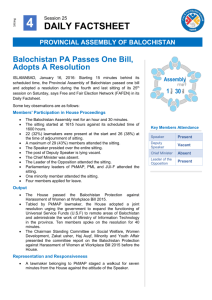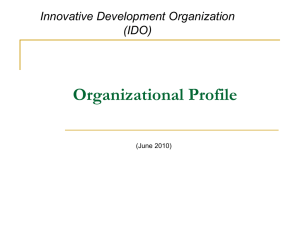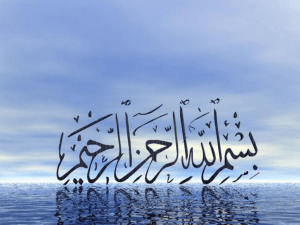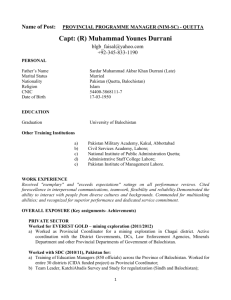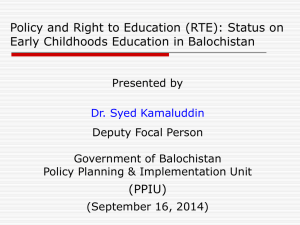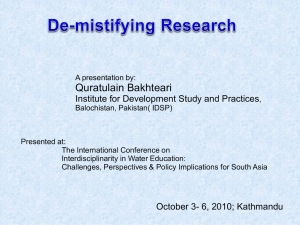Balochistan Youth Policy 2015
advertisement
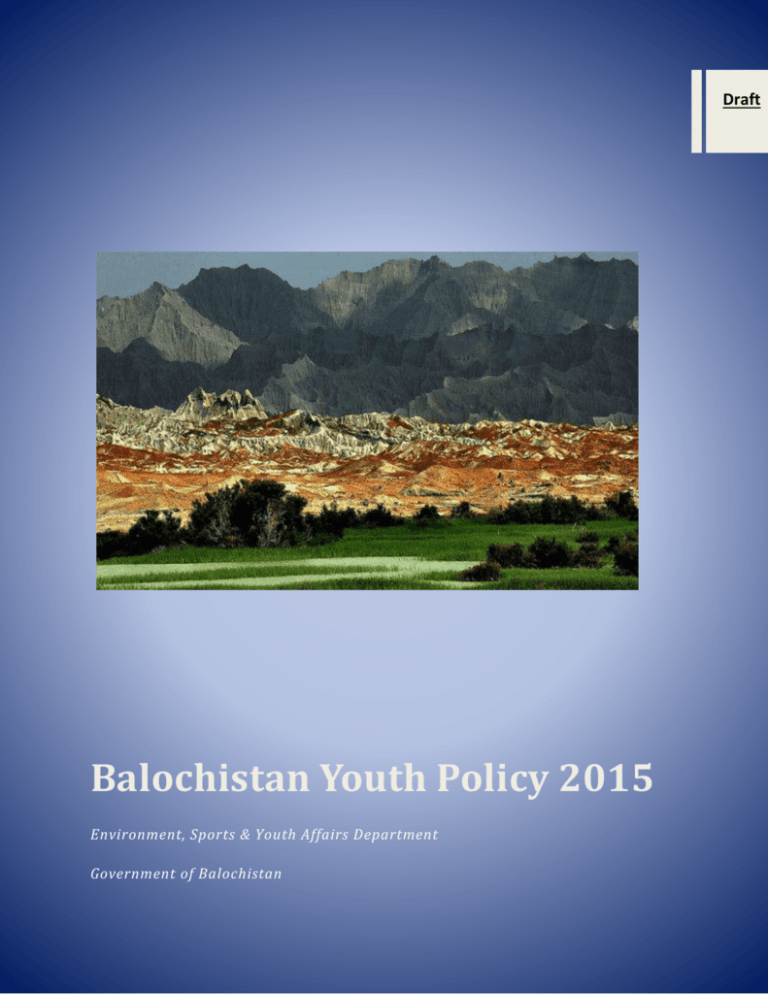
Draft Balochistan Youth Policy 2015 Environment, Sports & Youth Affairs Department Government of Balochistan Draft: 2015-08-04 Draft: 2015-08-04 Vision Balochistan youth policy envisions an empowered youth that is economically active with developed and quality competencies; is socially progressive, gender-friendly, sensitive to diversity and to the collective needs; and is engaged in peer and community interactions and decision making for uplift of civic and political affairs in Balochistan. Draft: 2015-08-04 Table of Contents 1. Preamble ................................................................................................................................. 5 2. Rationale ................................................................................................................................. 7 2.1. Youth Demography .......................................................................................................... 8 2.2. Situation of Youth in Balochistan ..................................................................................... 8 2.1.1. Economic challenges: .............................................................................................. 10 2.1.2. Social challenges: .................................................................................................... 11 2.3. 3. Governance: Youth Affairs in the Post 18th Amendment Era ........................................ 14 Strategic Direction ................................................................................................................ 16 3.1. Vision .............................................................................................................................. 16 3.2. Mission and Goal ............................................................................................................ 16 3.3. Objectives ....................................................................................................................... 16 3.4. Principles of Policy.......................................................................................................... 17 3.5. Mission Orientation and Priority Youth Groups ............................................................ 18 3.6. Employment and Livelihood........................................................................................... 18 3.7. Education for Youth Development................................................................................. 21 3.8. Integrated Health, Population and Gender Parity ......................................................... 23 3.9. Sports, Art and Culture ................................................................................................... 24 3.10. Protection of Youth .................................................................................................... 26 3.11. Youth Engagement and Participation ......................................................................... 27 4. Institutional Mechanism and Capacity Building ................................................................... 28 5. Annexure: Results of Perception Survey for Formulation of the BYP 2015 ......................... 30 Draft: 2015-08-04 Government of Balochistan Balochistan Youth Policy 2015 1. Preamble Youth offer the key human resources for future. Their productivity, social outlook and engagement indicate the outcome a country has to achieve, and whatever the results are they are the most important beneficiaries of national development. In Pakistan and Balochistan, they are, additionally, the largest demographic group in an age of the youth bulge. The commitment to their active participation to the development processes and holistic and crosssectoral empowerment in a systemic way have prompted the Government of Balochistan to formulate the Balochistan Youth Policy (BYP) 2015. It was also necessitated after induction of the 18th Amendment to the Pakistani Constitution, which transferred authority over the Youth Affairs from the Centre to the Provinces. The BYP 2015 is in line with parameters of the Balochistan Comprehensive Development Strategy (2013-2020) and the (proposed) Development Vision and Strategy (2015). This synergy will further consolidate planning and development work of the present Government that has taken upon over-due tasks of development planning and sought to expand from project and scheme-based development into a province-wise framework for development. The BYP 2015 pursues a course to engage youth of a province, which is generally marred by extreme poverty, lack of infrastructure and services and connectivity issues, making them vulnerable to risks attached with vulnerabilities. Based on an empowerment model, the policy is a comprehensive tool to uplift holistic situation of youth in economic, social and civil/political fields. Through the policy, the Government will support youth achieving their personal development and help them build their economic competencies and lifeskills. Thrust areas of the policy are employment and entrepreneurship; education for economic and social competencies; lifeskills; gender; integrated health and sports; tourism; peacebuilding, and youth engagement. A matching institutional mechanism will be set at place to integrate youth work undertaken within different sectors; while youth organizations will be made the Draft: 2015-08-04 5 Government of Balochistan Balochistan Youth Policy 2015 mobilizing arms of the Government. The Environment, Sports and Youth Affairs Department will be the focal point and coordinating agency for implementation of the policy. Draft: 2015-08-04 6 Government of Balochistan Balochistan Youth Policy 2015 2. Rationale The Government of Pakistan defines ‘youth’ as those young persons who are between the ages of 15 to 29 years. They form the largest section of Pakistani and Balochistani population. It is time that their group identity is recognized in public policy and all related work spread over sectors of education, finance, health, women, sports, youth affairs, etc., is integrated into a systemic package of youth empowerment in Balochistan. By this policy coherence, the youth can be brought at the center of provincial and national development. Such need is doubly emphasized in case of Balochistan which is marred by resource deficit, under-development, poverty and a sense of deprivation pervading especially in the educated youth who find fewer opportunities to absorb themselves into narrow base of job markets and tapered democratic and civic spaces for mobilization of their rights and organizations. The basic function of the BYP 2015 is to prepare grounds in economic, social and political/civic fields to engage rising expectations of the Balochistani youth for actual mobilization of their potential in operation; so that they are active, hopeful, enlightened and be part of their own making in personal and socio-economic development and the gap between youth aspirations and actual youth efforts is gradually decreased. While recognizing the macro-level constraints been historically prevalent – physical infrastructure, connectivity, population density and consequently expansive development, poverty and planning frameworks, the BYP 2015 puts premium on youth and proposes customized actions according to the needs of a diverse youth of Balochistan. It envisages complementing the regional clustering/corridor approach, especially in economic sphere, as proposed by the Balochistan CM’s Policy Reforms Unit (CMPRU). The BYP 2015 is also cognizant that the province has a diverse youth population in terms of ethnicity and sub-cultures and regional geography and location along with gender and education differentials. Unlike other parts of the country, Balochistan’s vulnerable youth make a sizable portion as in ratio of its total population. Draft: 2015-08-04 7 Government of Balochistan Balochistan Youth Policy 2015 The policy will seek to address needs of this diverse youth in a comprehensive manner and envisages programming guidelines that are unique to its different cohorts. The basic function would be to activate youth for its empowerment. 2.1. Youth Demography According to projected data, mid-year 2015, youth between 15 and 29 years of age are 30.6 percent amounting to around 61 million (31.5 million boys; 29.5 million girls) in Pakistan. All persons in 0-29 years of age are 126 million (64.9 million boys; 61.1 million girls) making it 63.1 percent of the total population of Pakistan. In Balochistan, the number of youth (15-29 years) amounted to 26.8 percent, while the number of persons between 0-29 years of age reached 70.2 percent, according to the 1998 census. This implies that the next cohorts of young people entering into youth category (15-29 years) have actually increased in both numbers and percentages (29 percent in 2005, according to the Economic Survey of Pakistan). This is coupled with data of the housing survey completed in 2011 that found a phenomenal increase in both population and housing in the province. The survey indicated that 139.3 percent increase in population was witnessed in Balochistan from 1998 (last census) to 2011, which surpassed in ratio than any other province and region in Pakistan. In numbers, the population was amounted to 13,162,222 not including the districts of Khuzdar, Kech and Panjgur districts. The province also witnessed highest increase of 109.2 percent in households across Pakistan. Roughly 74 percent of the population in Balochistan lives in rural and mountainous area. Apart from ruralurban/hilly and male-female divisions, this population is composed of diverse linguistic and cultural sub-groups and spread over a rate of 19 people per square kilometers. 2.2. Situation of Youth in Balochistan Balochistan in its present geography was formed a province after the former Balochistan States Union and former Chief Commissioner's Province of Balochistan were merged in 1970. The Government incorporated the coastal enclave of Gwadar later in 1977, which was purchased from Oman in October 1958. Being the largest province, it accounts for 44% of Pakistan's total land mass and is spread over 347,190 square kilometers (134,050 sq mi). Draft: 2015-08-04 8 Government of Balochistan Balochistan Youth Policy 2015 The province is enriched with natural resources. 50 metallic and non-metallic minerals have been found in Balochistan, of which 41 are being mined. Despite this, it is an under-developed province with infrastructure deficit and dependence upon primary sector economy – to the extent that some analysts put Balochistan in the horticultural and pastoral age, where minor crops and livestock are the largest sectors accounting for a quarter of the provincial economy. Manufacturing and finance together account for a mere 9%. Human development indicators are on a proverbial low and water for irrigation and drinking is scarcely available. Overall poverty incidence in Balochistan (48 percent) was estimated to be 13.5 percentage points higher than the other provinces of Pakistan in 2001/02. Urban poverty amounted to 44 percent with a relative decrease in the city of Quetta. Balochistan: District-wise Ranking in Indices of Multiple Deprivations (IMDs) 1 2 3 4 5 6 7 8 9 10 Deprivation Level Deprivation Level Deprivation Level LOW MEDIUM HIGH Quetta Pishin Harnai Ziarat Killah Abdullah Sibbi Mastung Jafarabad Kalat Jhal Magsi 11 12 13 14 15 16 17 18 19 20 Bolan/Kachhi Gwadar Khuzdar Awaran Kharan Nasirabad Panjgur Sherani Zhob Washuk 21 22 23 24 25 26 27 28 29 30 Kech/Turbat Nushki Killah Saifullah Lasbela Musakhel Chagai Barkhan Loralai Kohlu Dera Bugti Jamal, Haroon. "Districts’ Indices of Multiple Deprivations for Pakistan," Social Policy and Development Centre: Karachi: 2012. 43 percent of children in the province are estimated to be underweight due to malnutrition and food security reasons. Employment rates show a significant gender differential, estimated at 66.2 percent for males in Balochistan and 11.4 percent for females. Literacy is only 45 percent lagging behind the national average by 12 percentage points. Gender disparity is highly evident in both urban and rural areas and so is the infant mortality rate for Balochistan (@72 deaths per 1000 live births). There has been an increase, from 5.8 to 7.06, in the total fertility rate between 1991 and 2004 and contraceptive prevalence rate was recorded at an average of 14.7 percent. Balochistan data on HIV/AIDS, Malaria and other diseases is largely unavailable. Draft: 2015-08-04 9 Government of Balochistan Balochistan Youth Policy 2015 Balochistan is further mired in security issues, militancy, sectarian killings and widespread violations of human rights; which directly affects youth as the main causality of security risks and an uncertain future. The BYP 2015 recognizes the pressing situation of security and is committed to make spaces for political and civil engagement of youth in Balochistan. The secondary data about Balochistan is telling but for the purpose of formulating the BYP 2015 it was deemed necessary to generate primary data to map issues from the youth perspective and research was conducted. By using the empowerment model, a perception measuring instrument was developed; whereby the three key youth challenges were divided into subissues and perception ranking was sought to level of the provincial regions. Field research of this youth mapping exercise involved 18 consultative sessions in sample 11 districts, 700 participant youth from all 30 districts, 452 filled forms of a perception survey, 57 indepth interviews with experts and practitioners and around 150 organizations during this mapping exercise. Results of the perception survey research are annexed at the end of this policy document. The BYP 2015 is informed by this collective articulation of youth challenges that has helped identifying areas and appropriate strategies for the policy intervention There are three broader challenges faced by youth: (i) economic empowerment, (ii) social empowerment, and (iii) political/civic engagement; under these three main categories, there are multiple sub-issues which need to be addressed through the policy. It is also important to note the variations in results along gender, rural-urban, age-groups and regional lines. 2.1.1. Economic challenges: The youth in Balochistan face multiple economic challenges. A variety of such issues will include unemployment, lack of required skills for employment, lack of structures for labor development, poverty, feudal and tribal system and inflation. Both urban and rural youth rate unemployment as the biggest problem faced by the youth. However, the problem is severer in rural areas as compared to urban centers. The female youth rate unemployment as higher as compared to males (74%). Youth in the age-groups of 20-24 Draft: 2015-08-04 10 Government of Balochistan Balochistan Youth Policy 2015 and 24-29 rate unemployment highest. Poverty and lack of structure are rated as second and third, while lack of necessary skills, inflation and feudal system are rated lowest. Total number of employed and unemployed people has increased in Balochistan over the past few years indicating an increase in the workforce. Total civilian labor force in 2012-13 was 2.58 million which has increased to 2.85 million in 2013-14. Moreover, youth living in low deprived areas such as Quetta, Pishin, Jaffarabad and Sibbi rank unemployment highest. This youth group comes from first and third proposed economic corridors and areas of highest population densities. This shows that there is a need to develop infrastructure and increase employment opportunities in these areas. About 51% of the total people employed are working in agriculture, forestry, hunting and fishing industry. The province produces fruits and vegetables. Due to lack of irrigation systems and arid climate, it is difficult to practice year round sowing and cultivation. In some areas, 'Karez' system is still used for limited irrigation. Wholesale and retail trade, employing about 15.2% of the employed people, is the second biggest sector. Initially the government's focus is on developing the primary sectors which will in turn lead to development of secondary and tertiary sectors. The single largest employer in urban areas is wholesale and retail trade, restaurants and hotels. It is important to note however that manufacturing employs just 8% of urban residents while public administration and health and education sectors each employ around 10% of the urban workforce. Female employment is extremely low in urban areas and mostly in agriculture, health and education services. Local market analysis and skills mapping is another question, which has to be addresses; while the availability of trained and quality labour force is also intrinsically linked with the state of quality education. 2.1.2. Social challenges: It is imperative that the economic empowerment of youth is synergized with social uplift of young individuals who are progressive, egalitarian and sensitive Draft: 2015-08-04 11 Government of Balochistan Balochistan Youth Policy 2015 to common good of the society. Given under-development and diversity of youth in the province maintaining this equilibrium is a must. Social challenges being faced by the youth of Balochistan include education for youth development, integrated health and sports, drug addiction, gender biasness and barriers for male and female youth, peacebuilding and cohesion, sense of corruption/nepotism/social injustice, youth physical and psychological insecurities, promotion of culture and local art, discrimination against minorities/ marginalized youth, suicide among youth and lack of youth activism and volunteerism. Education is the key driver of socio-economic development. However, for the purpose of youth development those aspects of education are directly relevant which cause to inculcate social and economic competencies in youth. This is primarily the realm of quality education, including lack of education for skill development; enhanced learning outcomes; institutional framework i.e. regulation and standardization; curricula issues; non-academic programming and extracurricular activities; career counseling, and socially-sensitive and enlightened envisioning of education enabling youth to practice the values of peace, gender, equity and critical thinking. The rural youth rate issues such as lack of education for skill development and lack of quality education and curricula issues higher as compared to their urban counterparts signifying major rural-urban gap. Lack of institutional framework is rated highest by both rural and urban youth. While transport and travel issues are rated lowest among rural and urban youth as well as among all age groups. However, Females rate transport issues slightly higher as compared to males. So far the focus of education has been the access issues. Overall there has been a rise in the literacy rate in the province. The combined female/male literacy rate in 2012-13 was 49.8% which has risen to 51.8% in 2013-14. Initially, there is a need to develop primary and secondary school infrastructure as well as skill development schools in rural areas while universities and research facilities must be constructed in urban areas especially in southern Balochistan in corridors four and six. Draft: 2015-08-04 12 Government of Balochistan Balochistan Youth Policy 2015 However, the main issues related to youth development remain at large. The policy decisions need to consider issues with the current curriculum. It must be ensured that content of textbooks is free of any biases, stereotypes and aggression promoting material as well as should avoid defining gender roles in static ways. Furthermore, instead of opting for a uniform system of education, special emphasis must be laid upon standardization of evaluation tools. The design of curriculum must include learning outcomes that must be achieved at each progressive level of education. The curriculum should focus on developing logical and critical thinking rather than memorization of facts and rote learning. While unavailability of health centers and facilities is rated highest, females rate pro-youth legislative measures on (early) marriage higher as compared to males. On the other hand, youth health and sport is rated higher by males as compared to females. This can be attributed to historical continuity of sports facility for boys. Also youth health and sport is rated highest by the youngest age group, which is 15-19 years old. Integrated health and population related problems for youth mainly concern reproductive health. The communication gap related to reproductive health education currently exists due to cultural norms and stigmas attached to discussing own bodies and physical changes. Integrated health issues extend from physical to psychological and social aspects of well-being and gender parities in societies. There is a dire need to impart knowledge related to these topics to youth so that they can know themselves more and improve their decision making process. The particular areas that need to be covered should include naturalization of puberty, contraception and sexual health, sexual rights and choices, inappropriate touching and sexual abuse, etc. In Balochistan around 7% of women aged 15-19 had already started motherhood. In vulnerabilities, males rate drug addiction higher as compared to females) while corruption/nepotism/feudalism and social injustice is rated higher by females. A significant difference exists when it comes to the issue of gender biasness and barriers for male and female youth, the females rate this issue much higher as compared to males. This shows the Draft: 2015-08-04 13 Government of Balochistan Balochistan Youth Policy 2015 gravity of problems faced by females and lack of awareness on part of males regarding this issue. Similarly, physical and psychological insecurities are rated higher by females than males as social set up makes females more vulnerable to physical and psychological attacks. Linguistic differences and suicide among youth is rated lowest by both females/males and among all age groups. 2.1.3. Political participation and engagement: Finally, the issue of political participation and engagement of youth has been identified during field research for the BYP 2015. The problems under this category include: civic responsibility and citizenship, lack of political awareness, political participation to gain power, misuse of youth by political parties and lack of participatory platforms for youth. Almost all the categories are rated higher by urban participants showing a higher degree of political awareness. Females also rate civic responsibility/citizenship and lack of participatory platforms for youth higher as compared to males. Among all age groups, lack of participatory platforms for youth is rated highest. 2.3. Governance: Youth Affairs in the Post 18th Amendment Era There are two basic factors that have radically changed policy and implementation of youth affairs in Pakistan: (i) induction of the 18th Amendment to the Pakistani Constitution that has abolished Youth Affairs from the Concurrent List and transferred authority over youth affairs from the Centre to the Provinces, and (ii) the emerging realization of youth bulge in Pakistan that demands a matching policy and implementation response and multi-sectoral integration of youth development. The business is no more as usual! The latter factor has brought out the Youth Affairs Department from its peripheral role to the limelight of public policy, development programming and political nuisance. As a focal point of youth development in the province of Balochistan the Youth Affairs Department is now responsible for youth mainstreaming into all levels of policy and programming in the province. It is required to be more vigorously involved in line with the new constitutional arrangement. Formulation of the BYP 2015 indicates the emerging realities; Draft: 2015-08-04 14 Government of Balochistan Balochistan Youth Policy 2015 starting from its formulation, which will provide a comprehensive framework for youth development in the Balochistan. The Department was created as a wing for youth under the ministry of Culture and Sports in 1984. It was created with an aim to harness, guide and channelize youth’s potential towards positive activities by providing structural support as well as technical and social training. Its functions traditionally included tapping and utilizing the talents of mainly two youth groups – the illiterate and school dropout youth. Recognizing the youth bulge and the need for effective policy implementation regarding youth, the Department was upgraded to a full time ministry in 2005. However, it still works with one officer and within meager resources. Its key asset is a Youth Development Centre at Quetta which was constructed with the help of then Federal Ministry of Youth Affairs in 2008 with an estimated cost of Rs. 24.6 million. The Centre was expected to cater to needs of the youth of Balochistan by providing facilities such as debating hall, indoor games, boarding and lodging facilities, etc. The center is not fully functional as yet. After having adopted the BYP 2015, it is envisaged that the Department will duly expand into a comprehensive regime of youth empowerment in Balochistan. Draft: 2015-08-04 15 Government of Balochistan Balochistan Youth Policy 2015 3. Strategic Direction 3.1. Vision Balochistan youth policy envisions an empowered youth that is economically active with developed and quality competencies; is socially progressive, gender-friendly, sensitive to diversity, peace and to the collective needs; and is engaged in peer and community interactions and decision making for uplift of political and civic affairs in Balochistan. 3.2. Mission and Goal The policy will foster a culture of youth empowerment and participation in socio-economic sphere of Balochistan by providing an enabling environment, which mobilizes youth for their due rights and responsibilities as progressive, enlightened and lawful citizens and decreases their vulnerabilities, and enhances capacity of Government, private and social service providers to deliver accessible, relevant and high-quality youth-friendly services. By integrating multisectoral youth work, the policy will build synergies among different stakeholders in service of youth as partners of development processes in Balochistan. It will promote the values of respect for law, culture, diversity, gender, equity, peace and nation building. This policy effort will be to make grounds for Balochistan’s prospective entry into a new realm of national development, in the medium term, through peaceful mobilization of youth resources and on the longer run to strive for maximum equality close to national average indicators of employment, quality education, health and food security, gender equality and youth actions. The policy will also contribute to lay out an institutional framework for youth empowerment in the province. 3.3. Objectives To support youth for invoking the spirit of volunteerism and adherence collective actions. Draft: 2015-08-04 16 Government of Balochistan Balochistan Youth Policy 2015 To create an enabling environment for sustainable, rightful and gainful employment, livelihood, training, financial credit and other services. To promote a youth that is socially sensitive, egalitarian, pro-peace and gender-friendly. To promote education as a vehicle for youth development inculcating social and economic competencies for future roles in youth. To facilitate integrated healthcare ensuring reproductive health programming and services. To promote healthy lifestyle and mobility through sports and tourism and engage youth in preservation and promotion of art, culture and heritage. To engage youth in political/civic activities and encourage their organization and mobilization for personal, social and national development. 3.4. Principles of Policy That the youth will demonstrate respect for diversity of Balochistan and for youth and citizens from different perspectives other than their own i.e. language, gender, culture, orientation and socio/political loyalties, etc. That the youth energies be put in service of volunteer and political/civic activism and for full realization of citizenry. That the youth work has to be inclusive, free of discrimination until breach of lawful actions, and is sensitive towards social and economic protection of the vulnerable youth groups. That the rights and aspirations of youth require matching actions on part of the youth. That the youth have to be dynamic and brought out from the mindset of traditional jobs and into independent choice makers and entrepreneurs. Their ability and freedom to exercise choices is desirable. That the universal access to education will transform into the youth development sphere when qualified with value, quality and standards. That the youth health needs will also consider their psychological, social and economic vulnerabilities and its integration with gender equality. Draft: 2015-08-04 17 Government of Balochistan Balochistan Youth Policy 2015 That the holistic needs of youth imply coordination and integration of multi-sectoral efforts of the Government. 3.5. Mission Orientation and Priority Youth Groups The policy will pursue developing youth into active and responsible citizens and promote teamplaying and leadership skills among them for personal and socio-economic development. The Government will create opportunities and platforms for youth, especially rural and tribal youth, for increased participation in development programmes. Special efforts will be made to support initiatives of Boy Scouts and Girl Guide movements and link youth to public campaigns related to education, health, sports, environment, gender and peacebuilding and commemoration of national and international days. The government will also ensure that youth volunteers manage extra-curricular events and gain hands on experience of using skills like communication, coordination, event management, documentation and action-planning, etc. Public and private universities will be encouraged to initiate volunteer programmes for partial fulfillment of their degree programmes. In the social sector, NGOs and youth groups will be inspired to run youth-involving internship programmes with proper certification. Involvement in volunteer activities will enhance confidence and personal and professional interactions of the youth preparing them for their future social and economic roles. Another thrust of the policy is to strategically use the opportunities and platforms provided under its framework for peacebuilding and balanced gender-relations among youth. The priority youth groups of the BYP 2015 are: Literate youth, female youth, rural/tribal youth, youth from religious minorities and those addicted to substances. 3.6. Employment and Livelihood The Government will create an enabling environment of employment and livelihood opportunities for the youth; so that they are economically active on sustainable basis. It is Draft: 2015-08-04 18 Government of Balochistan Balochistan Youth Policy 2015 envisaged that the current mega-development projects in Balochistan will have the potential to accommodate Balochistani youth people with acquisition of better professional, technical and entrepreneurial skills. This will also result in minimizing regional disparities in the province. The current Government proposals of regional clustering and marking economic growth nodes will also ensure that all regions of the province contribute to economy according to their potential niche. Proposed Economic Corridor Non-Staple/high value products/coal/mineral No. 1 Districts in the Corridor Zhob, Killa Saifullah, Loralai, Sibbi, Musa Khel Ziarat Gas and crops in irrigated areas 2 Karachi-Khuzdar-Quetta-Chamman Corridor Gwadar-Mustung Corridor Port-Mineral Corridor Fisheries 3 Dera Bugti, Nasirabad, Jaffarabad, Jhal Magsi Lasbela, Khuzdar, Kalat, Quetta, Pishin 4 5 6 Gwadar, Panjgur, Washuk, Kharan Chagai, Washuk, Panjgur, Kech, Gwadar Gwadar, Lasbela The BYP 2015 recognizes that with skill development and vocational training the proposals of regional clustering and economic corridors can be duly implemented. For that, the policy is committed to carry out skills mapping studies preferably under the Balochistan TETVA to ascertain district-level skill-set in a given economic corridor. The public and private universities will also be encouraged to assign exploratory studies and student projects on skill mapping and market analysis in Balochistan. These assessment studies will highlight top-needed skills in respective economic corridors and be part of the existing TVET institutions. Based on these the Government will run regular and weekend programmes for skill development and technical training. The Government, private sector and relevant development agencies can fund such programmes. The Government will further run crash programmes in Training of Trainers (TOT) mode to the unemployed educated youth and link them with existing micro-credit facilities extended by private and social enterprises. Accordingly the Government will update curriculum of the vocational training institutes in accordance with clustering requirements and job-opportunities in the agriculture, livestock, Draft: 2015-08-04 19 Government of Balochistan Balochistan Youth Policy 2015 veterinary, mining, fruit processing and fisheries fields and will prepare a phased expansion programme of such training facilities to other growth nodes in Balochistan. Millions Workforce in Balochistan 0.000005 Urban 0 Total Total Male Total 2.58 2012-13 2.3 Rural 2.01 Urban 0.57 Female Total Male Female 0.28 2.85 2013-14 2.57 0.28 1.77 0.24 2.13 1.9 0.23 0.53 0.04 0.72 0.67 0.05 Total Rural Urban The Government will arrange soft loans for technical and vocational training recipients, when needed on merit basis, with the help of national and international agencies which are already implementing such programmes in other provinces of Pakistan. Female youth will be especially provided greater access to loaning facilities. To break taboos attached with technical and vocational education, the Government will arrange public service messaging, campaigns and Information Education Communication (IEC) materials to underscore the need for decent work especially among the literate youth. Youth will be made part of such dissemination. Moreover, the Government considers it equally important that both literate and illiterate trainees of technical and vocational programmes are properly certified; to duly win over access to national and international markets. The Government will strengthen institutions like the Balochistan TEVTA by striving to make the best use of its facilities and services. Private sector will be especially aligned to activate it. The Government will ensure to promote entrepreneurship and management skills among youth in cottage industry, local crafts and handicrafts, local trade fairs, hotel management, IT, Draft: 2015-08-04 20 Government of Balochistan Balochistan Youth Policy 2015 accounting and finance, marketing and branding, company registration, and office services, etc. To make the maximum practical use of such skills the public and private institutions will be encouraged to having access to credit facilities, market linkages and business planning as part of their regular programmes. The principle is to impart employable skills to the local youth and to encourage youth-led small enterprises for income-generation at village and urbanneighborhood level. Otherwise anonymous female workers may also avail such opportunities in local products and can directly reach out to the markets. Use of IT (social media) for youth is an area that can especially cut through physical handicaps and bring local products to the national and international markets. The Government of Balochistan is visible inclined towards expanding information access to its programmes, services and facilities through the IT interface and websites of its institutions. This is especially beneficial for literate youth and provides them leverage to make use of the public programmes, services and facilities in the districts that may remain outside knowledge of local communities. 3.7. Education for Youth Development The Government is constitutionally bound to provide right to education across the country. The provincial Education Department is making efforts to improve literacy, enrolment, retention, drop-out reduction, provision of missing facilities, school location, scholarships, education subsidies, girls’ education and other access issues. Nevertheless, this is technically the area of education sector to intervene. For the purpose of youth development, we have to be focused on quality education, including lack of education for skill development; enhanced learning outcomes; institutional framework i.e. regulation and standardization; curricula issues; nonacademic programming and extra-curricular activities; career counseling, and socially-sensitive and enlightened envisioning of education enabling youth to practice the values of peace, gender, equity and critical thinking. The Government will upgrade the status of Curriculum Wing and make it more pro-active; so that the required skill-sets in students are clearly spelt-out and acquired. They may include a Draft: 2015-08-04 21 Government of Balochistan Balochistan Youth Policy 2015 combination of hard skills (i.e. mathematics, problem solving, reading and information technology) and soft skills (i.e. oral and written communication, critical thinking, team work) and non-academic indicators (student-student/teacher interaction and platforms for selfexpression). So have to be learning outcomes at various stages of education and disciplines articulated and pursued. Pedagogy and the way to imparting knowledge is essential marker for success of education for youth development. The Government will ensure that design phase of such endeavour is made transparent and participatory; having proper call for public discussions and review on curriculum with a wide range of stakeholders. Quality teaching and student-centered methodologies are the key to groom students. For that teachers have to be updated with refresher courses in knowledge imparting methodologies. The syllabus in schools will further provide for curricular and co-curricular activities. Social sector will be encouraged to provide information and interaction opportunities for skill development and help youth to participate in democratic and civic processes. The Government will open doors of the prestigious institutions like Balochistan Assembly and the Governors House for visiting youth groups from schools, colleges and universities and provide them opportunities to interact with government personalities. Literate youth will be made essential part of the campaigns and during commemoration of national and international days. The curriculum will include special components on art, music and local geographies along with life skill education as part of the syllabus from class 5th. A system of invoking non-academic programming will be at place in schools and colleges to enhance competencies of the youth. The schools and colleges will be bound to prepare their curricular and extra-curricular calendars for the academic year. Inter-provincial exchange and scholarship programme by the Government of Punjab will be further extended to other provinces of Pakistan. Draft: 2015-08-04 22 Government of Balochistan Balochistan Youth Policy 2015 Specially designed vocational courses for girl students will be run in educational institutions. Rural/tribal groups will be provided crash courses on livelihood, life skills and health in nonformal settings. Given long distances and location issues, out of school and non-formal education and curricular activities will be promoted. Another policy guideline is to strengthen educational institution-community linkages. 3.8. Integrated Health, Population and Gender Parity The Government of Balochistan pledges to provide youth-friendly primary healthcare that are in line with integrated health framework and practices, delivering programmes, facilities ad services to match youth needs and aspirations. The Government recognizes adolescence and youth health rights that secure physical, mental and social growth of youth and boost their social, economic and political development. The Government will insure that systems are in place, in coordination with other private operators, for information and counseling of adolescents in the areas of gender relations and equality, violence against adolescents, responsible sexual behavior, responsible family planning practices, family life, reproductive health, sexually transmitted diseases, HIV infection and AIDS prevention are important to tackle the youth rights issues. It is however underscored that while delivering sexual reproductive services, the cultural sensitivity issues will be taken into consideration. Availability of facilities to support changes in youth bodies and physical condition are critical for individual youth and their families. Such services will include information and counseling on sexuality, safe sex and reproductive health; Contraception and protective method provision; STI diagnosis and management; counseling (and referral for testing and care); Pregnancy testing and antenatal and postnatal care; Counseling on sexual violence and abuse (and referral for needed services); and Post-abortion care (PAC) etc. The Government is cognizant that Pakistan has endorsed ICPD (International Conference on Population and Development), which has shifted the emphasis of population planning to promoting rights and sustainable development. Furthermore, Pakistan is also a signatory to several international treaties and conventions including Convention on Rights to Children (CRC), Draft: 2015-08-04 23 Government of Balochistan Balochistan Youth Policy 2015 the international covenant on Economic, Social and Cultural Rights. Such international treaties and conventions commit the country to right of young people. National commitment to the Convention on the Rights of Child also provide the framework to the provincial government to adolescents and youth rights, based on gender equity and equality. Such integrated health approaches are crucial to protect vulnerable and disadvantaged youth. The question of gender discrimination is also linked with it. The policy frames its commitment to integrated health rights of youth in the context of a youth bulge in Balochistan and Pakistan. The government will coordinate youth researches, events and debates on the scale and depths of youth bulge in the province and mass awareness campaigns for promoting family planning in the province. Youth groups and organizations will be encouraged to disseminate information regarding healthful practices and health services. Promotion of healthy lifestyle and protection from harmful addictions such as tobacco and drugs would be important components of integrated healthcare. They will also be made active part of education programmes on nutrition, anaemia, early age marriages and reproductive health. The more information they get the more they can make responsible choices on sexual and reproductive matters. The policy will give priority to sharing information and building life skills in youth-led campaigns. This will also be complemented with formal education curriculum, non-formal education, and peer education approaches. The Government of Balochistan is specially inclined to promote formation of women youth groups and organizations. On the provincial level, the Government also commits to allocate 15 percent quota for women in entering jobs. 3.9. Sports, Art and Culture The Government of Balochistan will include physical education and sports will be included in the school and college curriculum. Standards will be designed and maintained for schools and colleges for provision of sports and recreational facilities and yearly calendars for sports will be Draft: 2015-08-04 24 Government of Balochistan Balochistan Youth Policy 2015 implemented. With activation for sports it is expected that a cadre of qualified sports trainers, communicators, umpires and referees will also be created especially in football. The Government will help sports associations to bring national events to Balochistan, creating opportunities for sports volunteers and engagement of youth in sports. The Government will review performance of its sporting associations and revamp their systems for incorporation of dynamic personalities who have entrepreneurial skills and linkages with the sports related corporate sponsors and bodies in Pakistan. Youth groups and organizations will be linked with sports associations to raise profiles of Balochistani players and create sports icons at the national and international levels through use of social media. The Government of Balochistan has held a successful sports and youth festival and intends to consolidate this mega event. It will be designed in a manner that a pool of youth event volunteers is every year established. Their hands-on experience of assisting events is a valuable asset for the future alongwith healthy competitions of the event. Art and Culture. The policy supports and encourages local arts and culture and to protect, preserve and promote rich cultural heritage and traditions efforts in Balochistan. Showcasing and exhibiting of local work will be supported with an aim for media visibility across Pakistan. Traditional crafts, performing, visual and fine arts will be promoted at the provincial, national and international level. The Government recognizes the potential of community-based enterprise for local artifacts. Local textiles and handicrafts will be promoted through micro-credit facilities at the community level and training will be imparted to the entrepreneurs for branding and marketing their products. Outreach programmes at the Local departments of fine arts will be set up to to undertake and facilitate training programmes. The departments will house facilities to exhibit arts and crafts. A Draft: 2015-08-04 25 Government of Balochistan Balochistan Youth Policy 2015 committee comprising of journalists, intellectuals and experts on folk and tribal culture will advise the Government. The Department of Youth Affairs will provide linkages of national theatre houses in the social sector to the universities, colleges and youth groups and organizations to form local theatre groups. Such theatre groups can add value to awareness campaigns within local communities. Youth Tourism. The Department in collaboration with the Balochistan Tourism Directorate will devise a “See Balochistan Programme” and promote its itinerary with the help of youth groups and organizations for visitors. The Government will also form a Backpackers Club consisting of youth for group tourism and guiding facilities. 3.10. Protection of Youth The Government will work to ensure protection of its youth from physical, mental, social, and psychological abuse. It will curb use of drugs, tobacco, and other toxic substances. The Government will mobilize its relevant departments to conduct youth-led awareness programmes and campaigns. Civil society organizations and youth groups and organizations will be encouraged to be part of these community education programmes. They will also be involved in registration of refugee adolescents and youth in the public documents. Special attention will be given to prevent youth entering into militancy. Activities to build peace, promote a culture of peace, and ultimately prevent conflict will be strengthened and supported. Youth who have shunned militancy will be provided with platforms to express themselves and to get into discussions on positive youth development. The Government will seek public and private universities and media persons to record case studies of those youth who have returned to normalcy from involvement in conflicts. The Government will also involve youth in public service messaging and campaigns against hate-speech and celebrating diversity of Balochistan. Draft: 2015-08-04 26 Government of Balochistan Balochistan Youth Policy 2015 3.11. Youth Engagement and Participation The predominant approach behind the BYP 2015 is to engage youth in different dimensions of public life in Balochistan. Its theory of change is built on the premise that if the formal systems allow youth to positively develop in economic, social and political/civic arenas risks of youth to engage in risky behavior are minimized. The political/civic arena implies choices offered beyond party politics and more is concerned with democratic and community participation of the youth. In this sphere, the Government will help creating platforms and forming groups and organizations both within communities and campuses. On campuses this would translate into associational work according to the choices, interests and affiliations of the literate youth. The Government also particularity supports the ideas of class representation and establishment of student councils on campuses for those aspiring students who are eligible with prescribed qualifications for leadership positions having no academic arrears. Within communities, the BYP envisages a robust role of youth groups and organizations and youth partnerships with local government institutions particularly in the fields of sports, arts, culture and mass awareness campaigns. Draft: 2015-08-04 27 Government of Balochistan Balochistan Youth Policy 2015 4. Institutional Mechanism and Capacity Building The Youth Affairs Department will be the focal point for coordinating activities related to youth development. The Government will expand its staffing base also absorbing technical personnel to implement the policy. Given resource constraints in Balochistan, a two-pronged focus will guide the policy implementation for systemically synergizing work of existing organization, bodies and groups (provincial departments, NGOs, youth groups, international donors, philanthropists, corporate bodies and community-based organizations). First is related to the establishment of a Balochistan Youth Development Commission and the second is to encourage growth and government patronage of youth groups in Balochistan. Housed in the Youth Affairs Department as its secretariat, the proposed Balochistan Youth Development Commission will be the supervisory arm of the implementation of the BYP 2015. It will be a multi-stakeholder body to monitor policy contours and progress of youth work in the province. It will help ensure that adequate action-planning and financing is at work and will support the Department to build public-private partnerships. It will also submit an annual report to the Chief Minister on the status of youth work in Balochistan. The Department will maintain database of youth groups and organization and will encourage them to work within framework of the policy. For that, a Balochistan Youth Development Resource Centre will be made functional, whose main tasks are to coordinate youth groups ad organizatios, help in registration of new and informal groups, conduct research and documentation, undertake information dissemination, and promote convergence of government and nongovernment programmes. Measures will be taken to increase the membership of youth groups and organisations with focus on gender balance. Balochistan Youth Development Resource Centre will also act as a hub to share information on youth training, conferences, scholarships and other opportunities. The policy implementation will be facilitated by a detailed operational plan. Draft: 2015-08-04 28 Government of Balochistan Balochistan Youth Policy 2015 The Government recognizes that the policy will be evaluated in the light of actual performance made for realizing a resourceful, progressive and egalitarian youth: by the economic opportunities it creates; hopes and sensitivity it socially generates; operatizes education to develop youth; health, well-being and gender equality it promotes; provides opportunities for sports and culture; guarantees to protect youth against vulnerabilities; and engages them in actions and decision making of political and civic affairs in Balochistan. Draft: 2015-08-04 29 Government of Balochistan Balochistan Youth Policy 2015 5. 30 Annexure: Results of Perception Survey for Formulation of the BYP 2015 Cumulative Score Economic Challenges 180 160 140 120 100 80 60 40 20 0 Male Female Urban Rural 15-19 a) Unemployment b) Lack of Required c) Lack of Structures Skills for Employment and Programs for Opportunities Labor Force Development Challenges Draft: 2015-08-04 d) Poverty e) Feudal System f) Inflation 20-24 25-29 30+ Government of Balochistan Balochistan Youth Policy 2015 31 Social Empowerment 120 Cumulative Score 100 80 60 Male 40 20 Female Urban Rural 0 15-19 20-24 25-29 30+ Draft: 2015-08-04 Government of Balochistan Balochistan Youth Policy 2015 32 Cumulative Score Education for Youth Development 200 180 160 140 120 100 80 60 40 20 0 Male Female Urban Rural 15-19 20-24 a) Lack of Institutional Framework b) Travel & Transport Issues c) Education for skill development d) Quality Education challenges Cumulative Score Integrated Health and Youth Population 200 150 Male 100 Female 50 Urban 0 a) Unavailability of b) Pro-youth c) Lack of awareness d) Youth health and Health Centres & legislative measures about Sexual and sports Facilities on marriage Reproductive Health Rights Challenges Draft: 2015-08-04 Rural 15-19 20-24 25-29 e) Curricula Issues & Peace Education 25-29 30+ Government of Balochistan Balochistan Youth Policy 2015 33 Political Participation and Engagement of Youth 120 100 Axis Title 80 Male Female 60 Urban 40 Rural 15-19 20 20-24 25-29 0 a) Civic responsibility and citizenship b) Lack of political awareness among youth c) political d) Misuse of youth by e) Lack of participatory participation to gain political parties platforms and youth power does realize its responsibilities towards the state. Axis Title Draft: 2015-08-04 f) Others 30+
